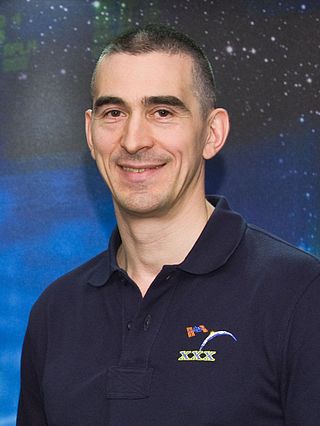
Nauka,also known as the Multipurpose Laboratory Module,Upgrade,is the primary laboratory of the Russian Orbital Segment of the International Space Station (ISS). Serving alongside the Rassvet and Poisk mini-research modules,Nauka conducts scientific experiments and stores research equipment.

Akihiko Hoshide is a Japanese engineer,JAXA astronaut,and former commander of the International Space Station. On August 30,2012,Hoshide became the third Japanese astronaut to walk in space.

Oleg Viktorovich Novitsky is a former Lieutenant Colonel in the Russian Air Force who logged over 700 hours of flight time and was awarded for bravery. He is currently serving as a Russian cosmonaut with Roscosmos and has participated in multiple expeditions,during which he has spent over 545 days in space.

The process of assembling the International Space Station (ISS) has been under way since the 1990s. Zarya,the first ISS module,was launched by a Proton rocket on 20 November 1998. The STS-88 Space Shuttle mission followed two weeks after Zarya was launched,bringing Unity,the first of three node modules,and connecting it to Zarya. This bare 2-module core of the ISS remained uncrewed for the next one and a half years,until in July 2000 the Russian module Zvezda was launched by a Proton rocket,allowing a maximum crew of three astronauts or cosmonauts to be on the ISS permanently.

Anton Nikolaevich Shkaplerov is a former Russian cosmonaut. He is a veteran of four spaceflights.

Mark Thomas Vande Hei is a retired United States Army officer and current NASA astronaut who has served as a flight engineer for Expedition 53,54,64,65,and 66 on the International Space Station.

The Orbital Piloted Assembly and Experiment Complex was a 2009–2017 proposed third-generation Russian modular space station for low Earth orbit. The concept was to use OPSEK to assemble components of crewed interplanetary spacecraft destined for the Moon,Mars,and possibly Saturn. The returning crew could also recover on the station before landing on Earth. Thus,OPSEK could form part of a future network of stations supporting crewed exploration of the Solar System.

Anatoli Alekseyevich Ivanishin is a former Russian cosmonaut. His first visit to space was to the International Space Station on board the Soyuz TMA-22 spacecraft as an Expedition 29/Expedition 30 crew member,launching in November 2011 and returning in April 2012. Ivanishin was the commander of the International Space Station for Expedition 49.

Prichal,also known as the Uzlovoy Module is a Russian-built component of the International Space Station (ISS). This cylindrical module has six docking ports to provide additional docking ports for Soyuz and Progress spacecraft,as well as potential future modules.

The year 2021 broke the record for the most orbital launch attempts till then (146) and most humans in space concurrently (19) despite the effects of COVID-19 pandemic.

Soyuz MS-17 was a Soyuz spaceflight that was launched on 14 October 2020. It transported three crew members of the Expedition 63/64 crew to the International Space Station. Soyuz MS-17 was the 145th crewed flight of a Soyuz spacecraft. The crew consisted of a Russian commander and a Russian and American flight engineer.

Expedition 65 was the 65th long duration expedition to the International Space Station. The mission began on 17 April 2021 with the departure of Soyuz MS-17 and was initially commanded by NASA astronaut Shannon Walker serving as the third female ISS commander,who launched in November 2020 aboard SpaceX Crew-1 alongside NASA astronauts Michael S. Hopkins and Victor J. Glover,as well as JAXA astronaut Soichi Noguchi. They were joined by the crew of Soyuz MS-18,which is made up of Russian cosmonauts Oleg Novitsky and Pyotr Dubrov,as well as NASA astronaut Mark Vande Hei.

Soyuz MS-19 was a Soyuz spaceflight which launched on 5 October 2021,at 08:55:02 UTC. It was the 147th flight of a crewed Soyuz spacecraft. The launching crew consisted of Russian commander Anton Shkaplerov,Russian film director Klim Shipenko and Russian actress Yulia Peresild. Shipenko and Peresild spent about twelve days on the International Space Station before returning to Earth aboard Soyuz MS-18,while filming a movie in space,The Challenge. The MS-18 flight launched two crew members of the Expedition 66. Without an American astronaut,this launch marked the first time in more than 21 years that a Soyuz crew only included Russian cosmonauts and travelers and the ship had to be upgraded to be piloted by a single person at launch. This is also the first mission to the ISS with an entirely Russian crew.

Pyotr Valerievich Dubrov is a Russian engineer and cosmonaut selected by Roscosmos in 2012.

Progress MS-17,Russian production No. 446,identified by NASA as Progress 78P,was a Progress spaceflight operated by Roscosmos to resupply the International Space Station (ISS). This was the 169th flight of a Progress spacecraft.

Progress MS-18,Russian production No. 447,identified by NASA as Progress 79P,was a Progress spaceflight operated by Roscosmos to resupply the International Space Station (ISS). This was the 170th flight of a Progress spacecraft.

Progress M-UM,was a specially modified Progress M 11F615A55,Russian production No.303,developed by Roscosmos to deliver the Prichal module to the Russian Orbital Segment (ROS) of the International Space Station (ISS). It was launched on 24 November 2021 at 13:06:35 UTC,along with a Progress-M propulsion compartment and has the pressurized cargo module removed to accommodate Prichal. This was the 171st flight of a Progress spacecraft. It was the final flight of a Progress M and the first launch of a Progress spacecraft on a Soyuz 2.1b.

The Challenge is a 2023 Russian space drama film co-written and directed by Klim Shipenko. Filmed on the International Space Station (ISS),it is the first feature-length film featuring actors to be shot in space. The film stars Yulia Peresild as a surgeon sent to space to help an injured cosmonaut. The cast also includes MilošBikovićand Vladimir Mashkov. The film crew was accompanied by cosmonauts Anton Shkaplerov,Oleg Novitsky,and Pyotr Dubrov,and NASA astronaut Mark T. Vande Hei.

Progress MS-21,Russian production No.451,identified by NASA as Progress 82P,was a Progress spaceflight launched by Roscosmos to resupply the International Space Station (ISS). It was the 174th flight of a Progress spacecraft.

Expedition 70 was the 70th long-duration expedition to the International Space Station. The expedition began with the departure of Soyuz MS-23 on 27 September 2023 with Danish astronaut Andreas Mogensen taking over the ISS command. It ended with the departure of Soyuz MS-24 on 6 April 2024.



























